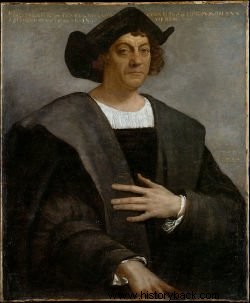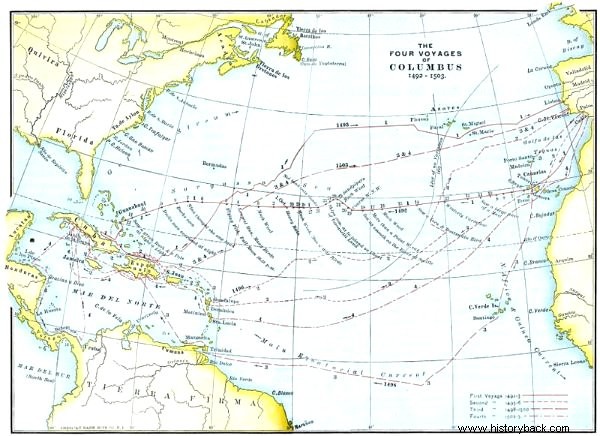Christopher Columbus was a Genoese navigator and explorer . He was the first European to arrive in the lands of the American continent, called the New World, in 1492.
Biography
 Portrait of Christopher Columbus
Portrait of Christopher Columbus
Christopher Columbus was born in mid-1451, apparently in Italy, probably in Genoa, the city in which he was a navigator and explorer.
He was a sailor from his childhood and a brilliant cartographer as an adult. His first trade was that of a weaver, however at the age of fourteen he began to sail.
Columbus is supposed to have lived more than nine years in Portugal, between 1476 and 1485. In 1477 he traveled to England and Iceland. In 1478 he made sugar-laden transfers between Lisbon and Madeira Island.
In the year 1482 he sailed with the Portuguese fleet, when he gained experience in navigation.
He started the conception of his project of voyage to the West, considering that Portugal had the best and most experienced sailors.
With the Portuguese denial of his plans, he went to Castile in 1485, where he remained until 1492, when he left Palos on his first expedition, out of a total of four. He died in Valladolid on the 20th of May 1506.
The Columbus Plan
Columbus' project was actually to cross the entire Atlantic towards Asia and thus defeat the commercial monopolies of the time.
This endeavor was encouraged by the debates on the sphericity of the earth, and by the readings of authors such as Aristotle, Strabo and Pliny, who were already debating from a distance between Europe, Africa, and India.
On the other hand, sailors' reports claimed that lands to the west existed. This corroborated Toscanelli's Map, on which Cristóvão was based, as well as other works on navigation of the period.
After carrying out his calculations, he presented his plans to the Portuguese Crown, which ignored them.
King Ferdinand V of Aragon (1452-1516) and Queen Isabella I of Castile (1451-1504) of Spain supported his plan.
They had the support of bankers and other investors and provided Christopher Columbus with three ships (Nina, Pinta and Santa Maria).
Note that Christopher Columbus died without receiving what he was entitled to under the agreement signed with the Spaniards.
Discoveries of Christopher Columbus
The feat that made Christopher Columbus famous was his leadership of the fleet that managed to reach the American continent on October 12, 1492.
This event was under the orders of the Spanish Crown, and it was "Eurocentrically" known as "Discovering America".
Columbus was a great cartographer. He planned a voyage from the Canary Islands to the island of San Salvador (present-day Bahamas) on October 12, 1492.
After a five-week voyage, the Genoese navigator did not discover America, but found a new territory inhabited by indigenous people, the Lucaians. They were peaceful and friendly, the same that Cristóvão claimed to be able to conquer with 50 men.
His second voyage began in 1493, and this time with much more resources (three ships and fourteen caravels). It was on this expedition that he found the islands of the Antilles and Martinique and, to the North, the region of Puerto Rico.
On the third excursion, in 1498, six ships reached the island of Trinidad. Finally, on the fourth and final voyage, Columbus left Cádiz in 1502 with four ships, reaching Jamaica and the island of Pinos in Honduras.
 Map with the route of Columbus' four voyages
Map with the route of Columbus' four voyages
The Controversies Over Christopher Columbus
There are some existing controversies in the investigation of the life of the browser. In the biography Historia del Admiral Don Cristóbal Colón , written by his son Fernando and the main reference for his studies, is unclear about some aspects of Columbus' life.
From the start, the most accepted version among historians is that Christopher Columbus was born in Genoa in the year 1451. However, the birth hypotheses indicate the years from 1436 to 1456.
However, the date of birth of the navigator can be defined with some precision if we consider the document of October 31, 1470. In this document, it is stated that Christopher Columbus was already over nineteen years old.
Another interesting point is the one in which Columbus demands from the Spanish Crown, as provided for in the agreement, 10% of the profits in the discovered territories. However, he was not answered.
This led to his heirs suing the Crown in a long-running legal dispute known as the "Colombian Claims".
Anyway, the Genoese died in Valladolid on May 20, 1506, at the age of 55. He possessed the wealth from the gold he amassed on his adventure, which is not unanimous, as there are indications that he ended his days poor.
Finally, it is unknown if his remains are in Santo Domingo or in the Cathedral of Seville, where they are currently located.
Curiosities
- The name Columbus inspired the name of a country, Colombia and two regions of North America:British Columbia, in Canada, and the District of Columbia, in the United States.
- Christopher Columbus was the first man to prove that the world was really round.
- Eight years after Columbus' discovery, Pedro Álvares Cabral sighted lands belonging to Brazil.
Continue your search by reading the articles:
- The First Great Navigations
- Portuguese Navigations
- Discovery of America
- European Maritime Expansion
- First Peoples of America
